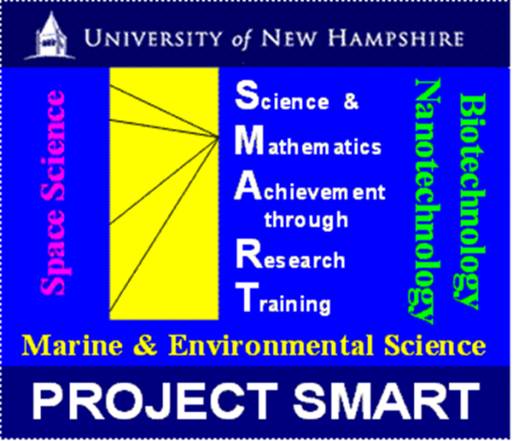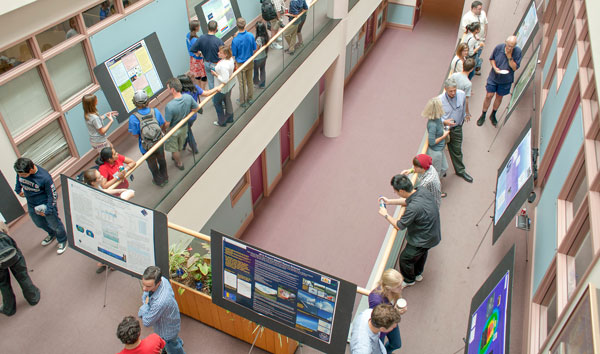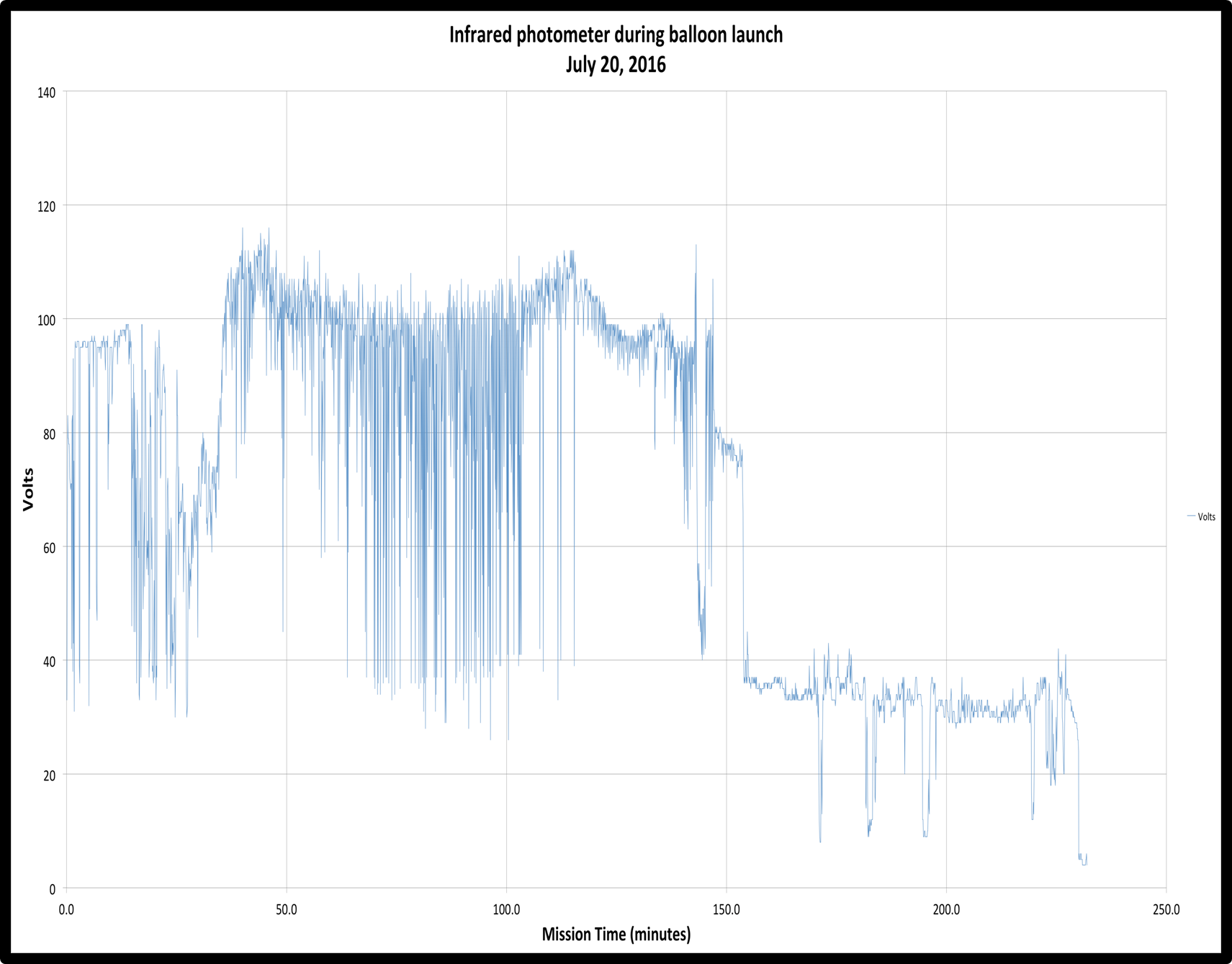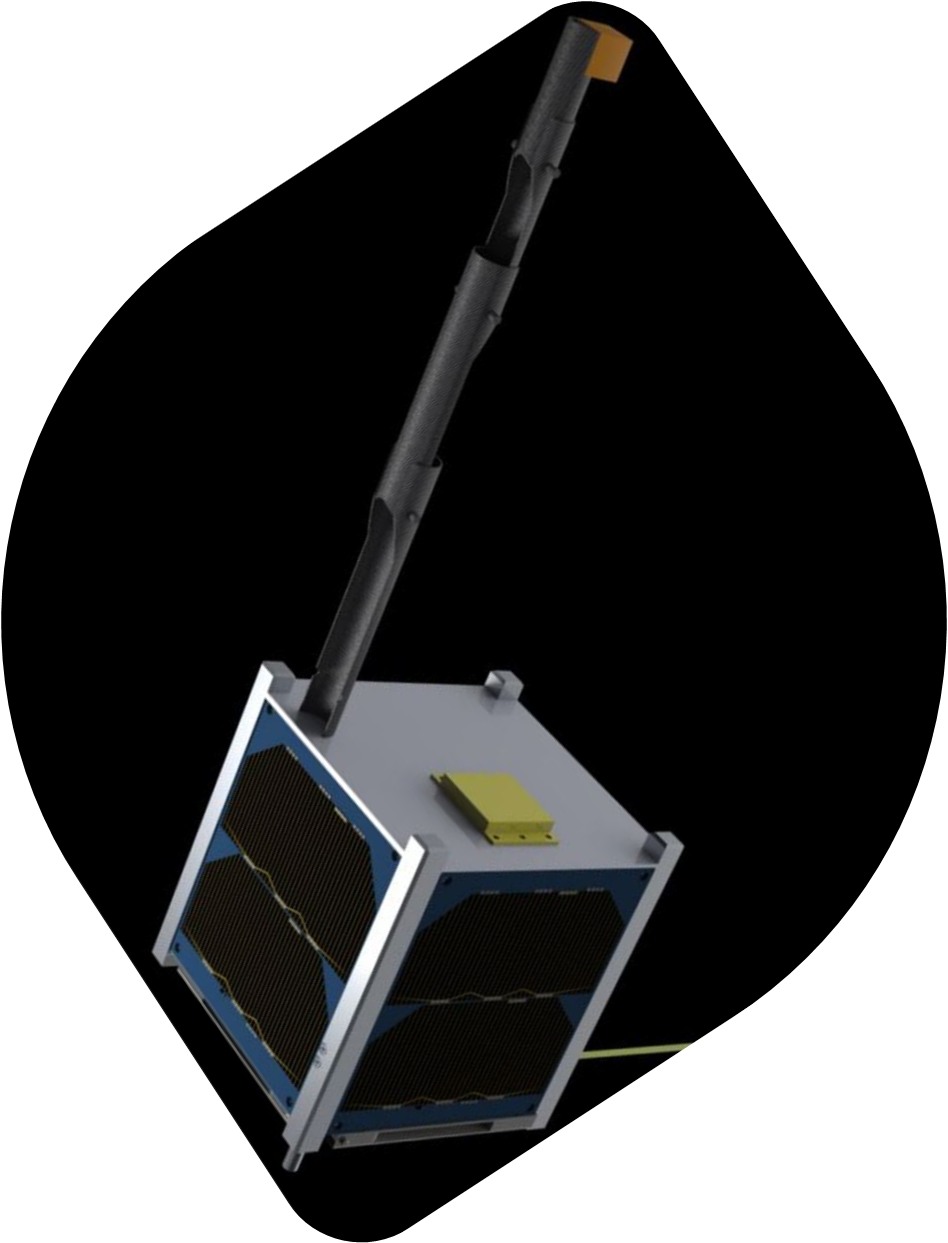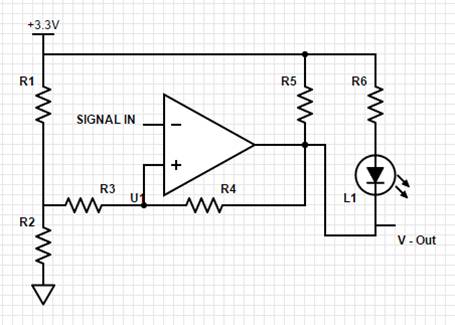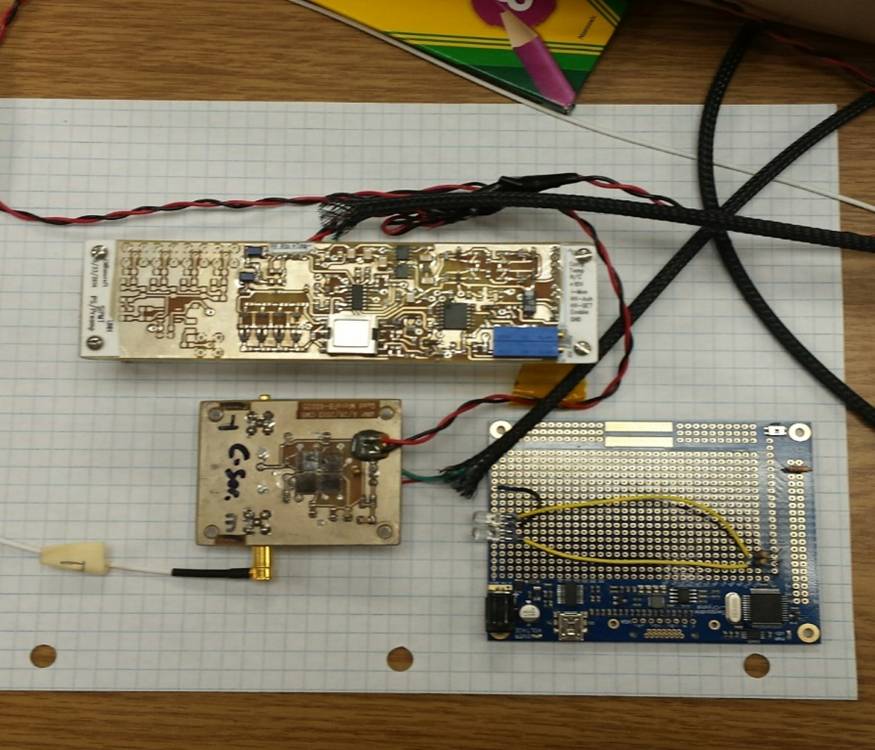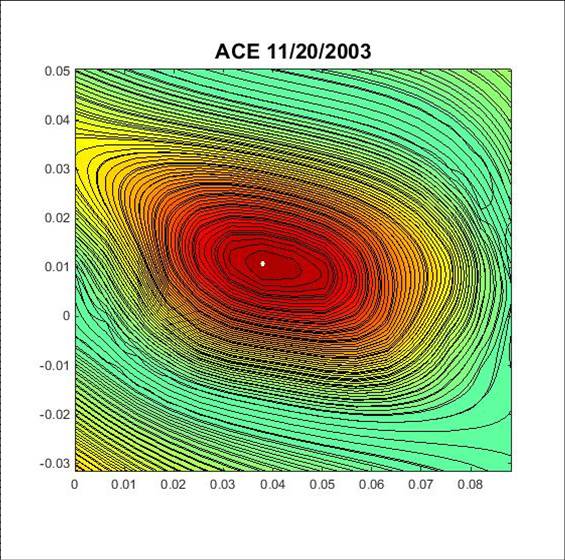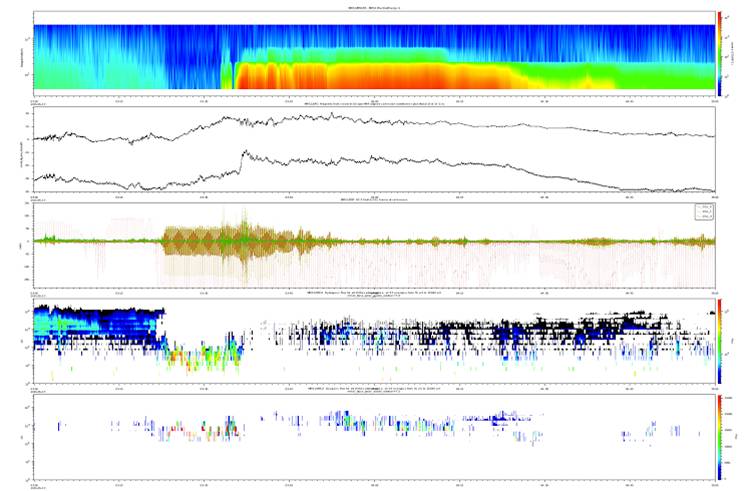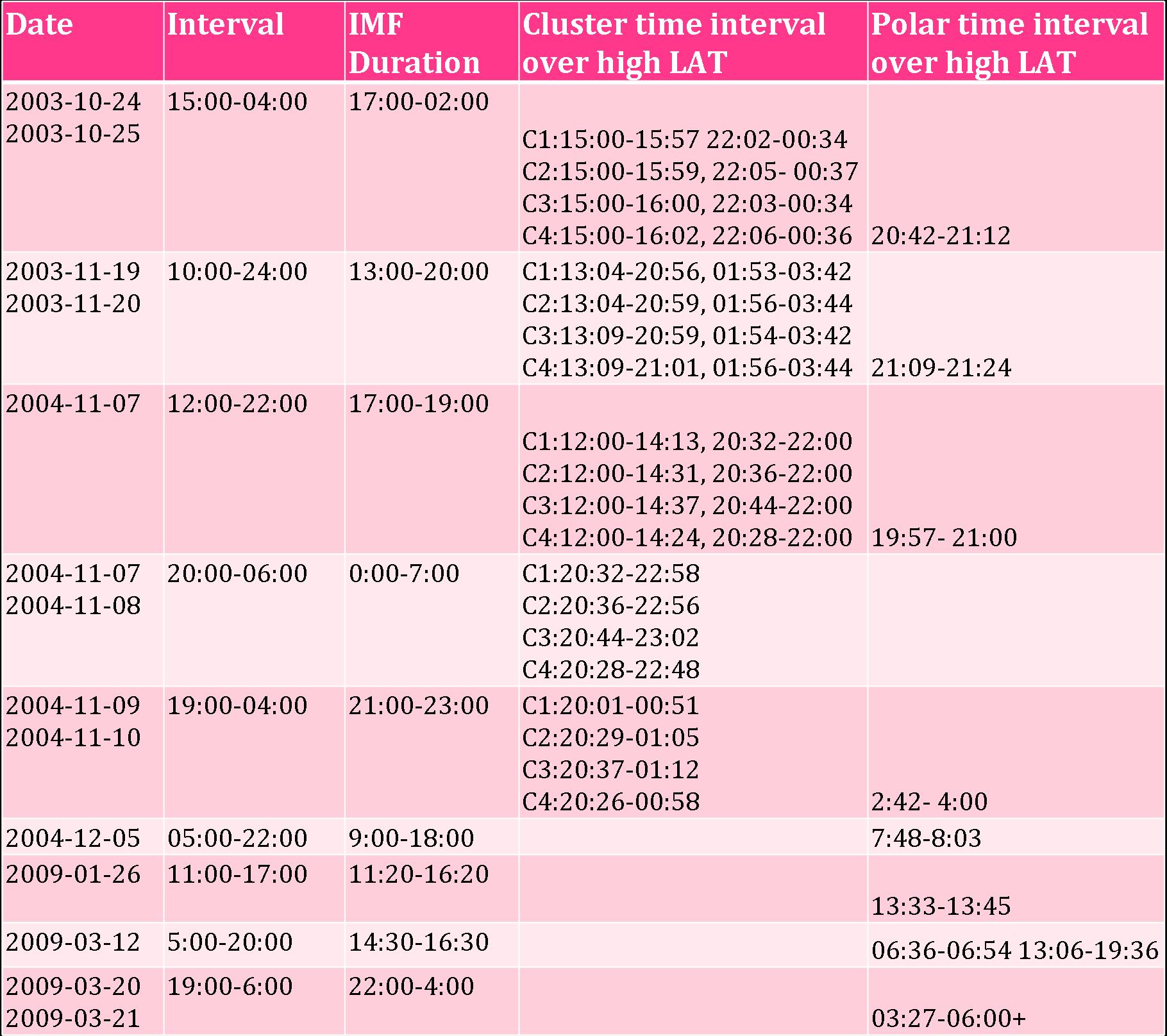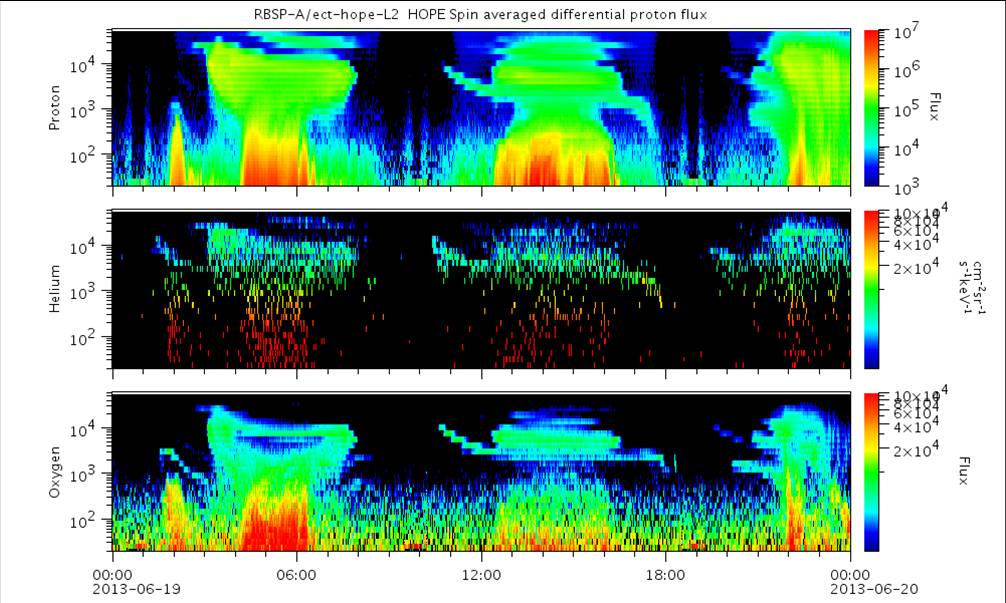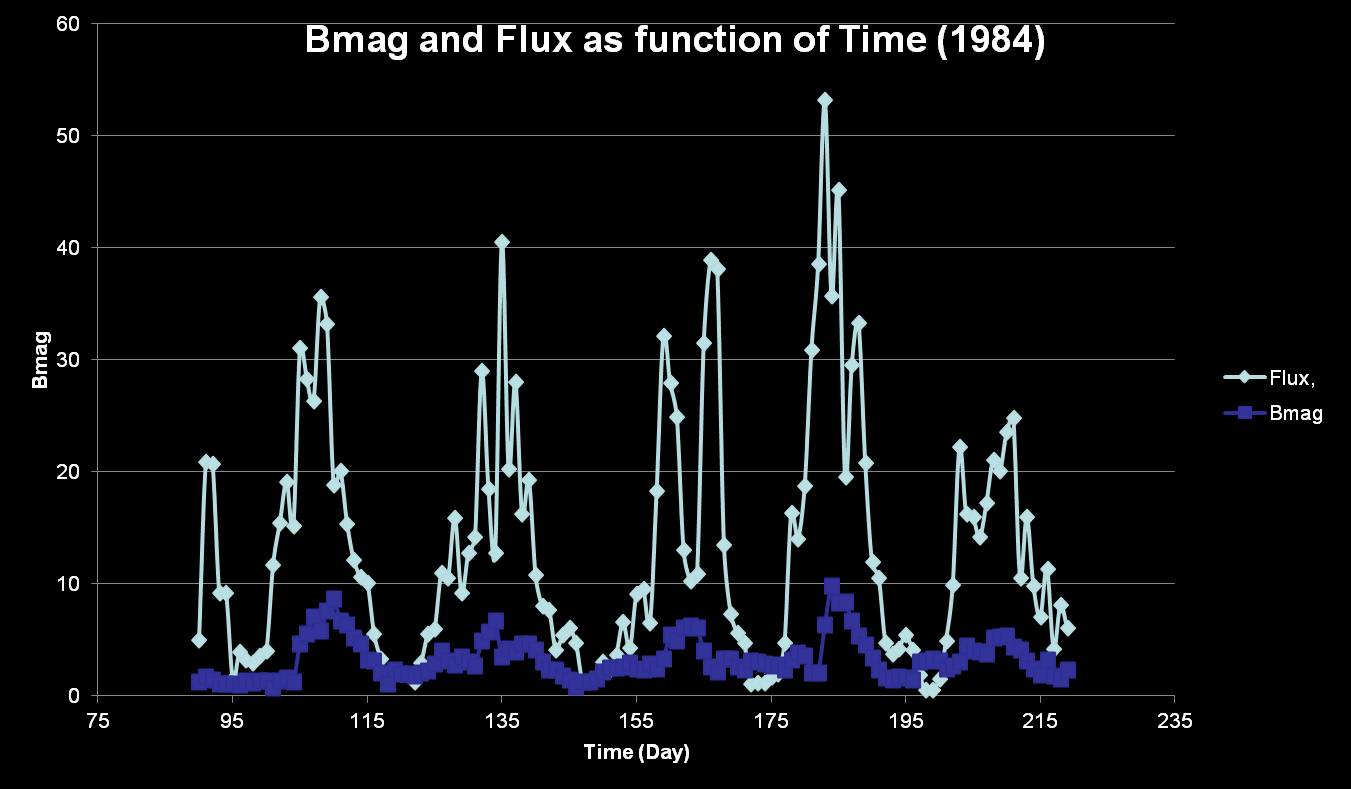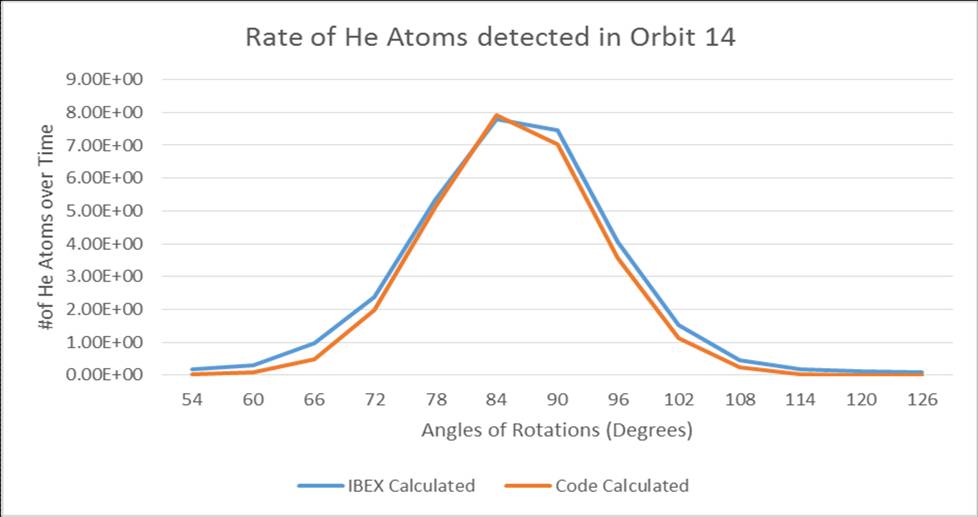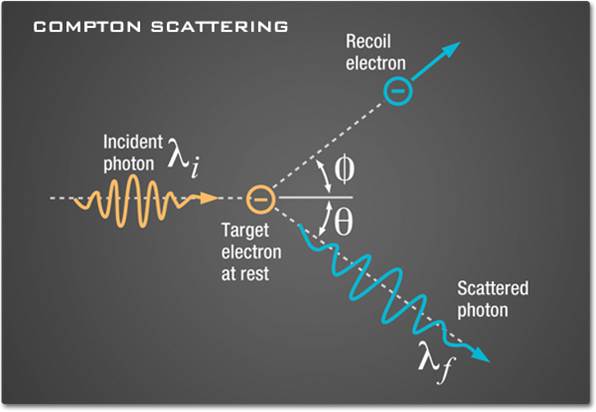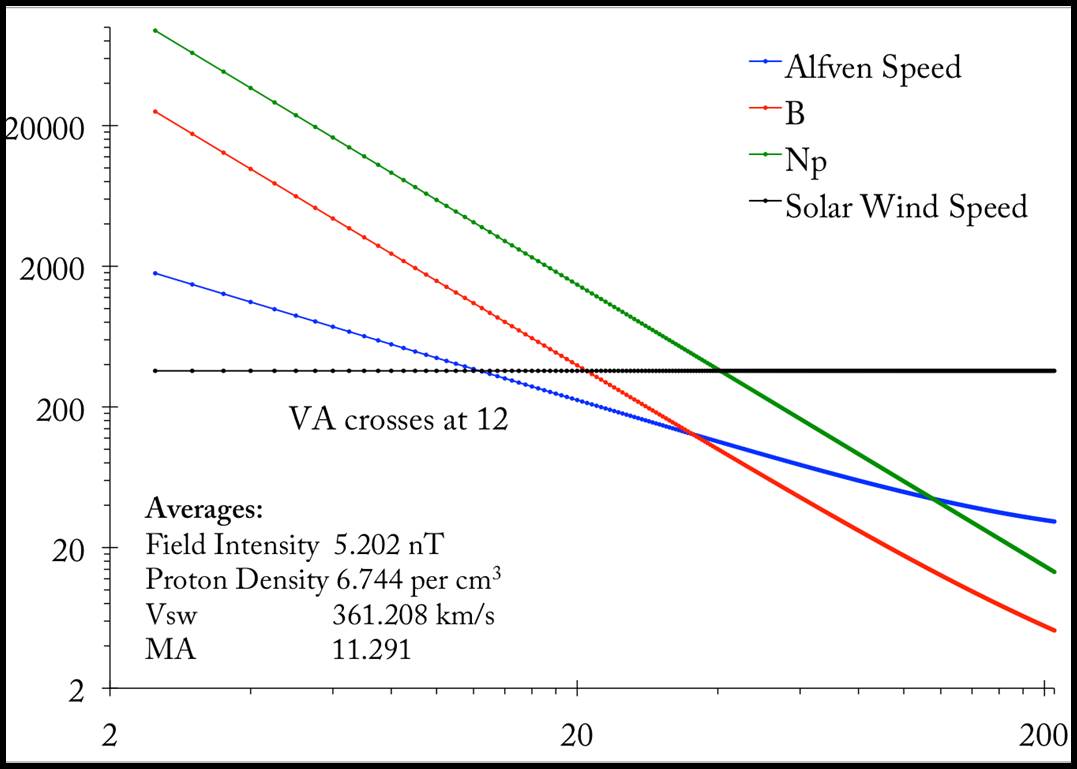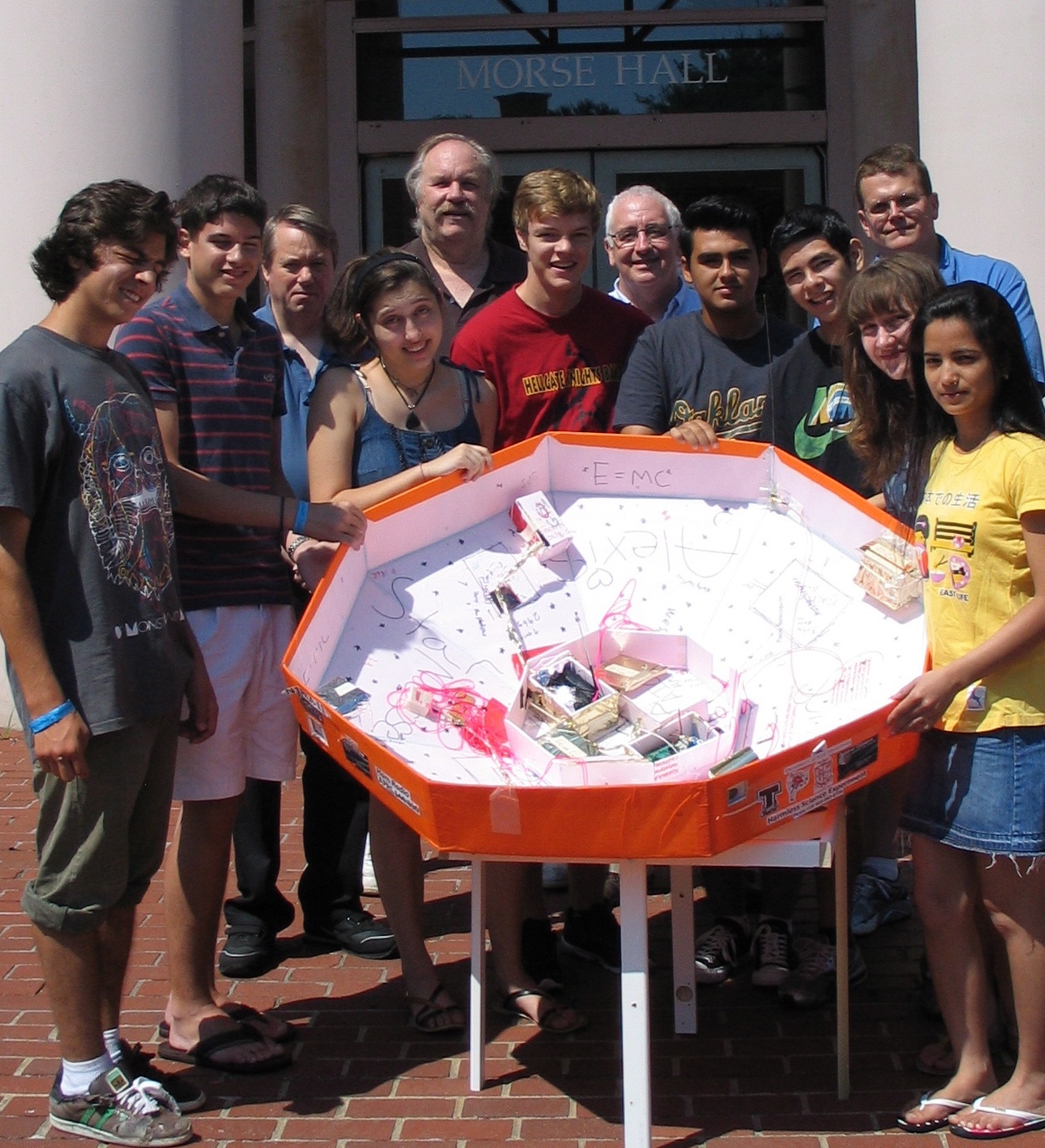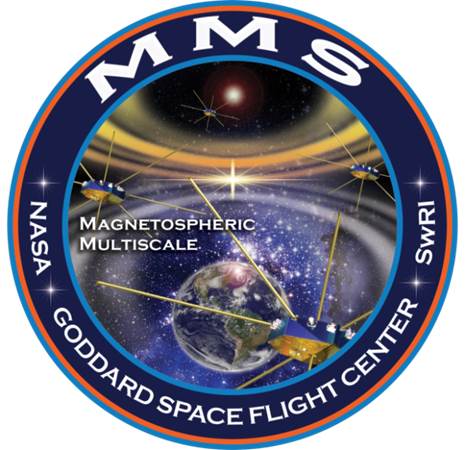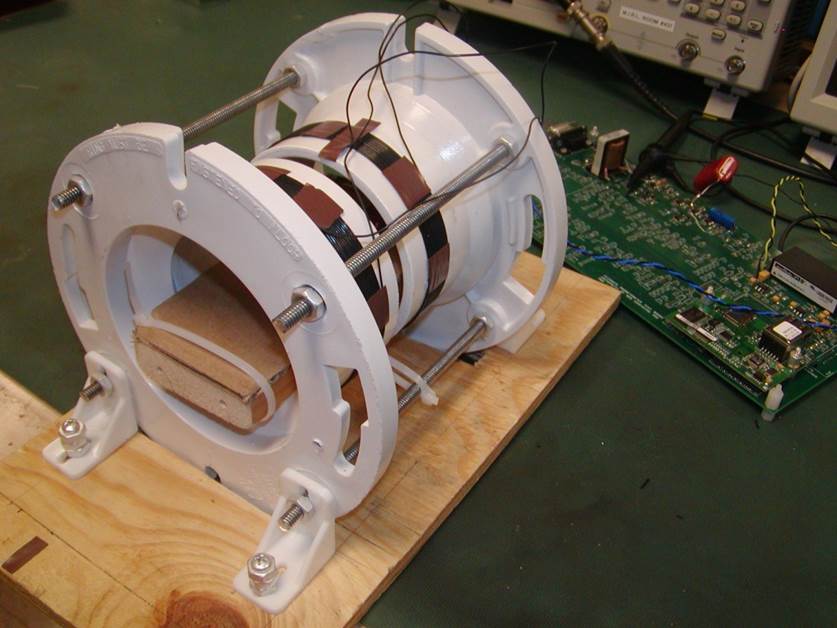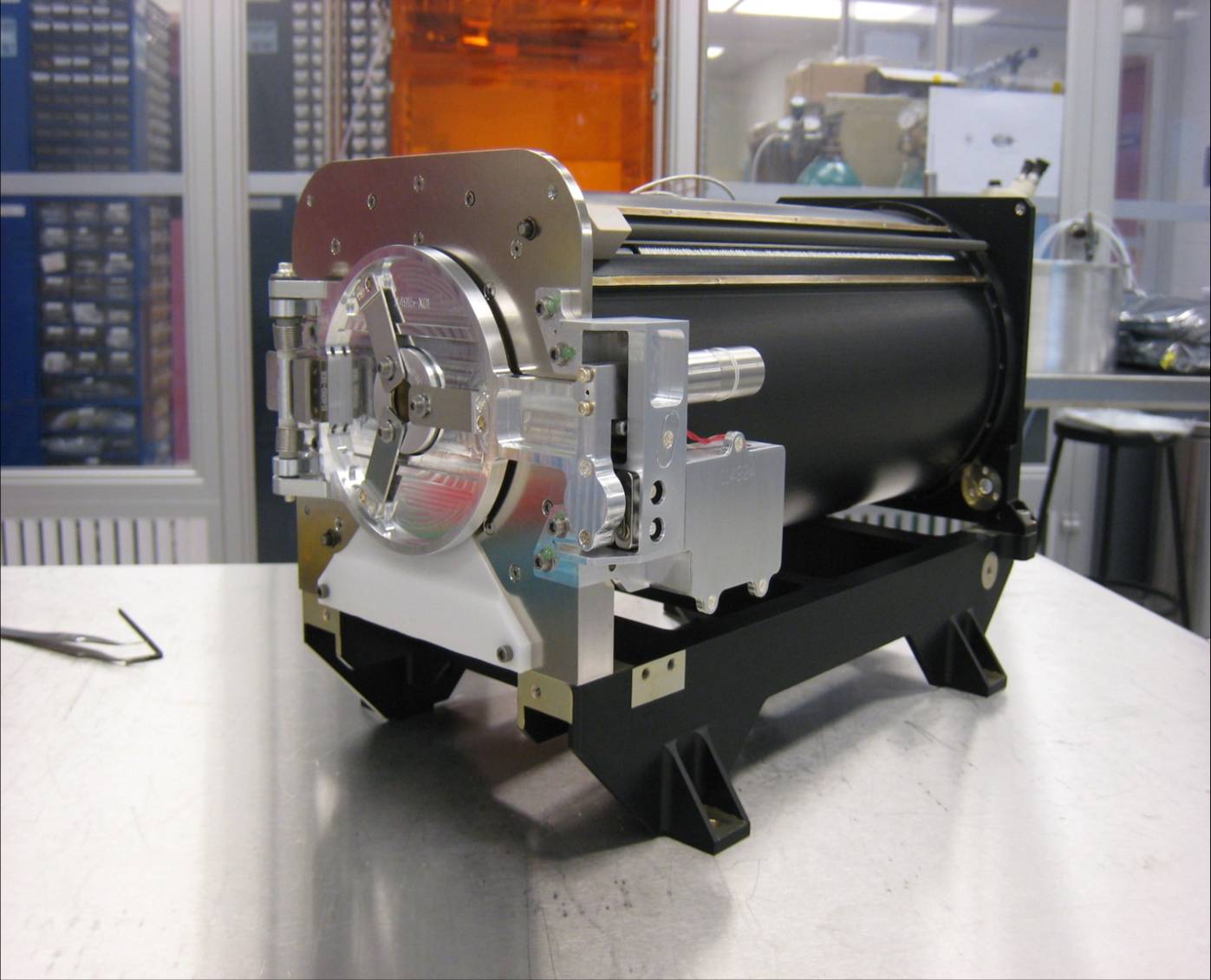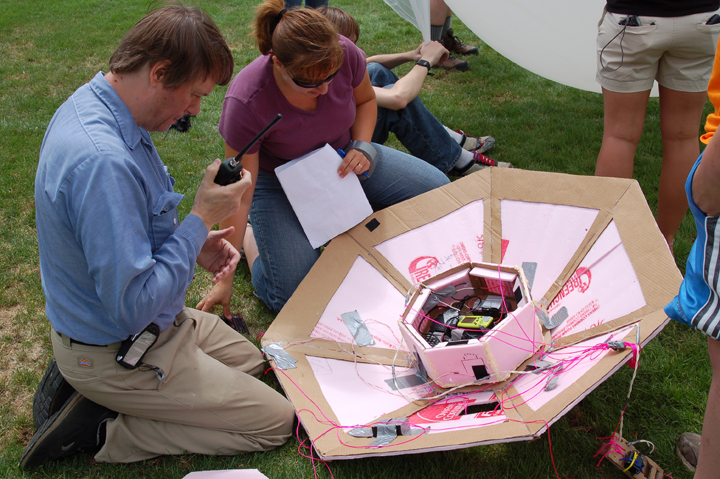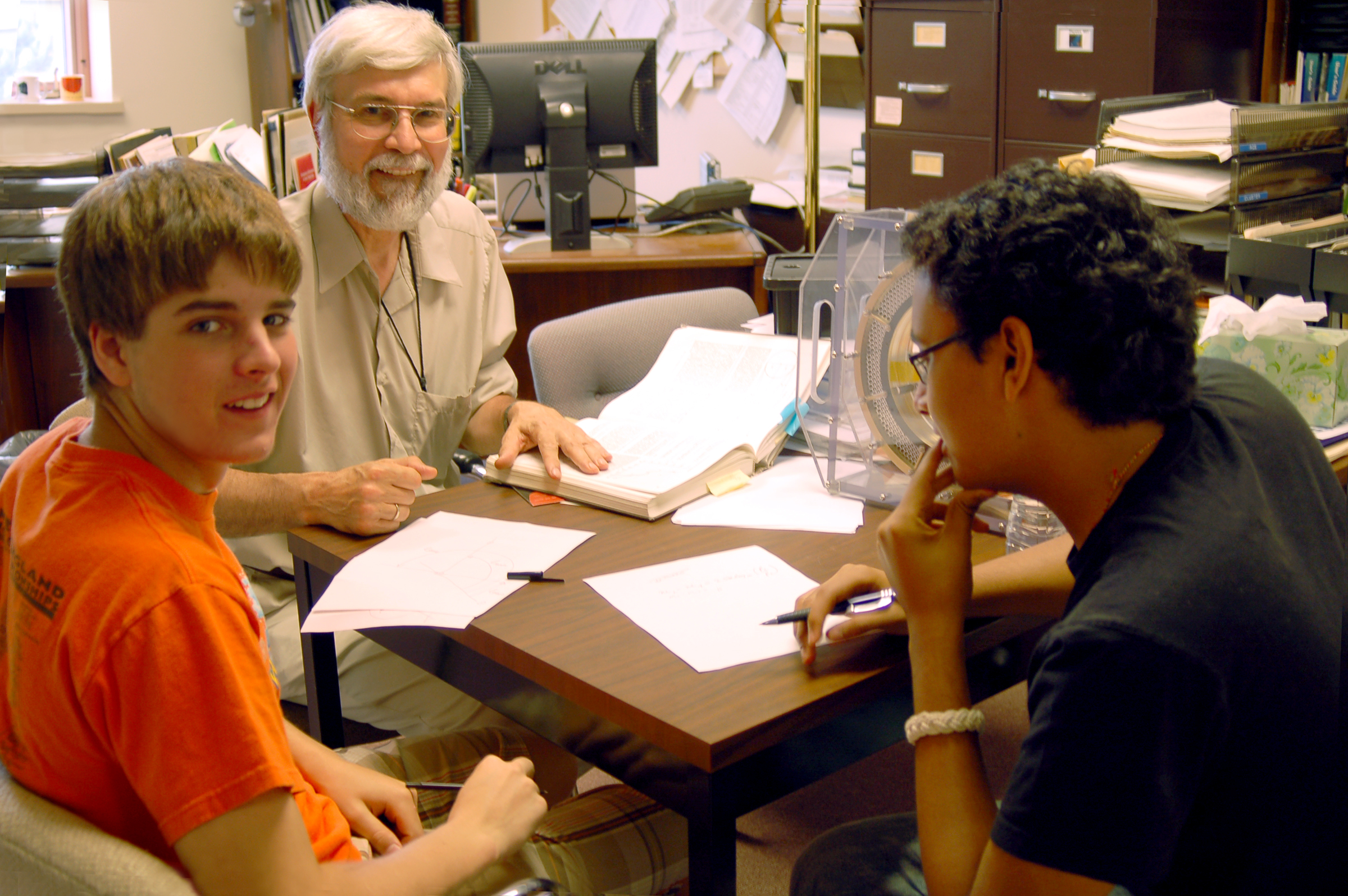Student Information
The Project SMART experience within the space science module is a hands-on experience. The entire month-long experience is built upon three activities:
- There are physics classes at the advanced high school and undergraduate college level led by our experienced high school teachers to provide the background needed to perform the physics and understand core principles. These lectures are supplemented by a wide variety of fun experiments and demonstrations. Our teachers have decades of classroom experience and they don't want their summer to be the same experience as they or the students experience during the school year. This physics is FUN!
- There are hands-on research projects exploring advanced space physics concepts that are led by the university professors with topics drawn from their own active research projects. Studens work singly ordoubly within a research group formed by the professor, research staff, graduate and undergraduate students. We will typically run 4 to 6 separate research projects each year so that students can select from different opportunities and activities. This is real-world scientific research using our laboratories, computers, and real spacecraft data. This experience is supplemented with seminars in space physics concepts to help the students understand where their work fits into the "big picture".
- There is a joint project where the students work together to build the scientific payload for a high-altitude balloon. The payload evolves every year to become more sophisticated and more capable. Students will learn everything from core physics to microprocessor programming and circuit building.
Here we offer glimpses into the activities and accomplishments of past years. For those who wish to see the short videos created from our balloon flights, we file them with YouTube and have links here. We encourage interested students to visit the teacher pages as well for additional insights into the program.
The end of the month brings graduation day. Each student team presents the results of their research to the other students, the faculty, their friends and family who assemble for the day. You will be amazed at what you can accomplish! Here we present some of the posters that have been prepared by the students for graduation day. Posters are prepared using PowerPoint, but are offered here in jpeg form as these files are smaller.
2016 Research Projects: Seven students participated in the program this year with students coming from as far away as Germany and Greece. In collaboration with the Environmental Science module, we flew 2 balloons. The first was a tethered flight above a pond where cyanobacteria was in high concentration. Ongoing measurements just above the water's surface have shown that the bacteria gets into the air in concentrations that equal the water-borne concentrations. Prof. Haney wanted to see if the bacteria became truly air-borne above the pond, so a tethered balloon lifted his air sampler to 100 feet for a prolonged sample well above the pond. Then the same air sampler was flown on the untethered balloon to 100,000 feet to see if cyanobacteria can reach the stratosphere. Another part of the untethered flight was the ongoing development of a multi-channel photometer to record the spectrum of light coming off the Earth's surface and propagating through the atmosphere.
- SMART students Paul Weimer, Ben Abraham, and Kelly Garcia working with Prof. Eberhard Moebius completed a study of interstellar pickup ions using the STEREO spacecraft. They looked for correlations between the properties of pickup ions and the solar wind. Here is their poster.
- SMART student Ethan Chapman worked with Prof. Jichun Zhang and graduate student Aly Aly in a study of Electromagnetic Ion Cyclotron (EMIC) waves seen by the RBSP spacecraft. He built a library of observations and an initial examination that will prove very useful in future efforts. Here is his poster.
- SMART students Grace Buttrick and Jiwan Nepal working with Prof. Marc Lessard and UNH students Tyler Chapman, Maria Panacopoulos and Anthony Velte developed a prototype magnetometer boom for an upcoming CubeSat mission. Here is their poster.
- SMART student Marios Dimitriadis working with Prof. Charles Smith examined newly discovered magnetic waves in the Voyager data set. He developed evidence leading to a possible explanation that the waves result from thermal anisotropies in the ambient proton distribution. Here is his poster.
- Our 2016 balloon flight was successful after a poor start on the first day. A failure of the balloon at 8000 feet caused the first flight to end prematurely. Four days later a successful flight to 102,000 feet provided our most recent test of the multi-channel photometer design built by the students and our attempt to find cyanobacteria in the stratosphere. Our poster describes the flight (The 2016 Balloon Flight). There is a video of the flight this year at https://youtu.be/MfEXJnj1vFw. Note that at times you can see Cape Cod to the south and the coast of Maine to the north during the descent near the coast. You can also hear the air sampling pump turn on and off. The pump was tested in vacuum to simulate the atmosphere at 100,000 feet prior to flight. The low battery alarm can also be heard near the end of the flight.
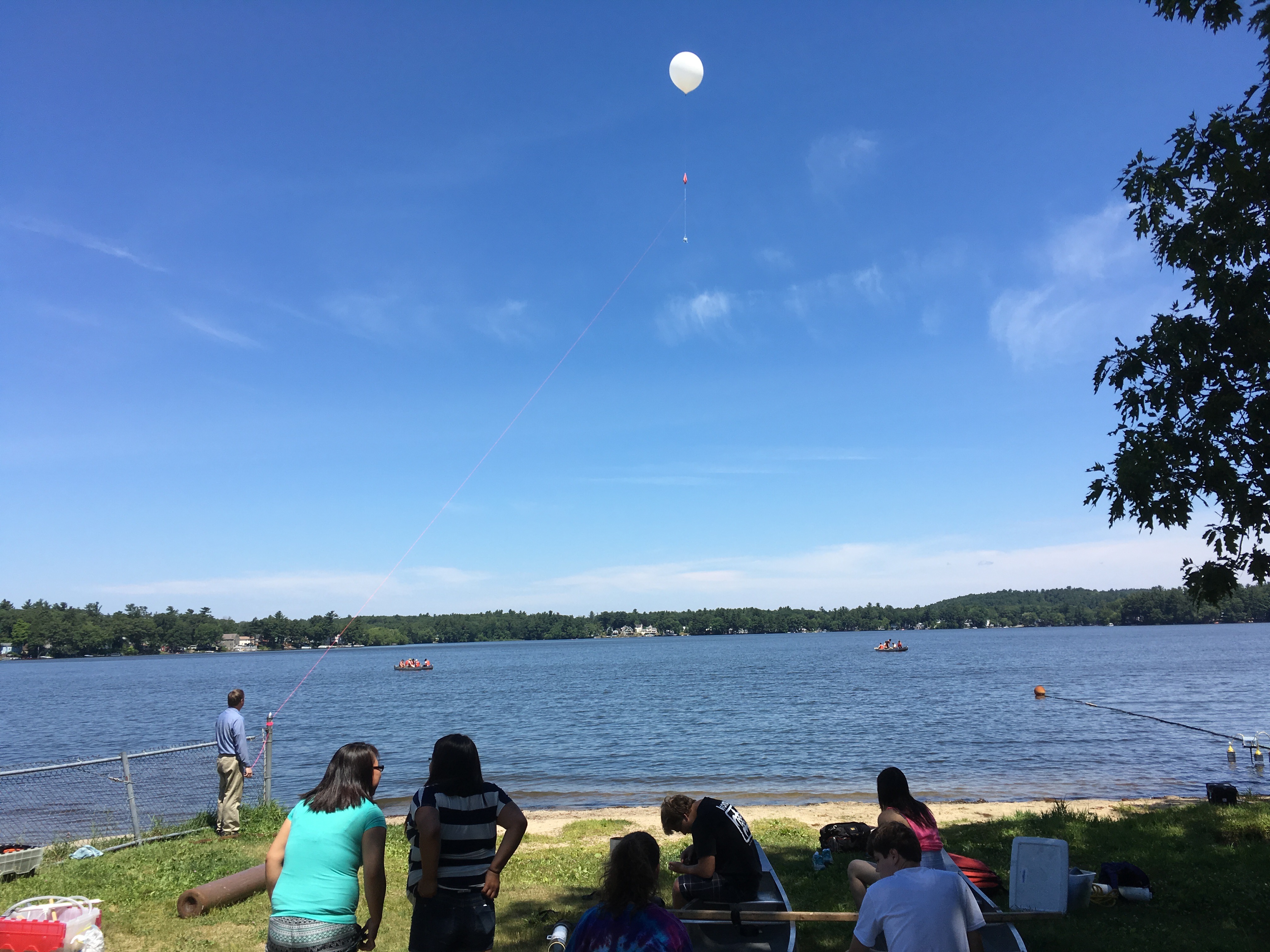
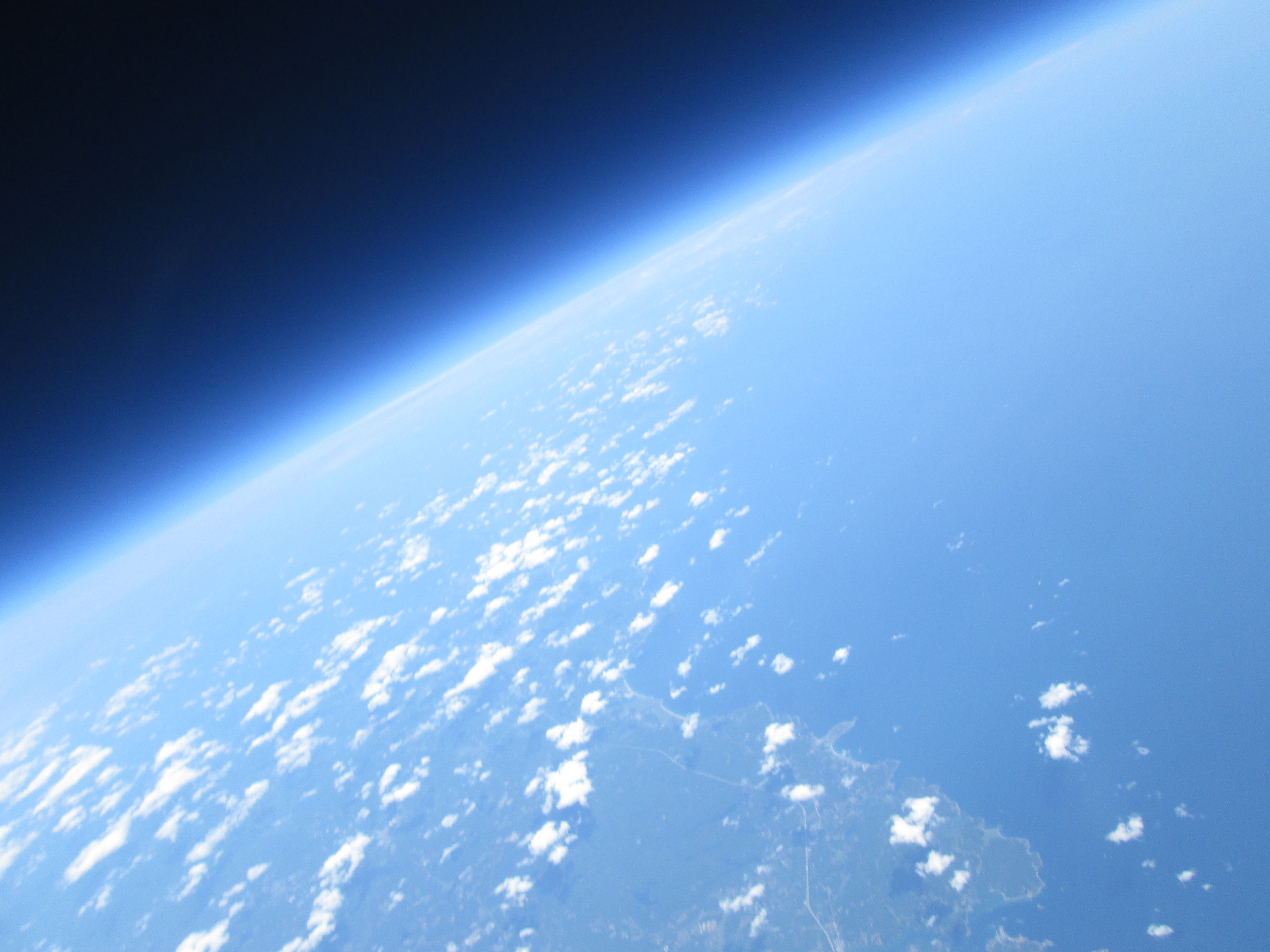
(left) The tethered balloon flying over a pond for study of airborne cyanobacteria.
(right) The view from 102,000 feet in July 2016 looking north along the Maine coast.
2015 Research Projects: Seventeen students participated in the program this year. They completed 8 research projects, built a balloon payload from scratch, constructed 6 new prototype instruments for flight and built several more to existing designs. These include a 5-channel spectrometer that recorded light intensity from the IR to the UV and in 3 bands in the visible range, a Sun sensor, and the interface for a gamma ray and energetic neurton detector designed by Prof. Peter Bloser that got it's first flight to the edge of space. Students built the data collection hardware for the gamma ray and energetic neutron detector. The payload also carried a Geiger counter built the year before. The balloon flew to 96,000 feet and inspite of a minor glitch on liftoff that resulted in an imbalanced payload the flight was a success.
- SMART students Biao Xie and Oriana Lara worked with Prof. Roy Torbert and Dr. Matt Argall. They performed a study of dipolarization events during times of strong Dst, which means that they used data from the newly launched MMS spacecraft to search for regions of magnetic reconnection. Here is their poster.
- SMART students Kent Cassidy and Dakotah Stirnweis worked with Prof. Peter Bloser, Mr. Richard Levergood, and recent graduate of the program John Gadbois to construct a data collection interface for a recently designed prototype instrument built by Prof. Bloser. The instrument is a compact form that measures gamma rays and energetic neutrons. This was the instruments first flight test. Regretably, a mishap on launch allowed light to enter the scintillate and the test was not successful. Laboratory tests proved that the device worked perfectly and it was only the intrusion of light onto the scintillator that caused the failure. A reflight is planned for October 2015. Here is their poster.
- SMART students Luke D'Cruz and Vasileios Georgopoulos worked with Kristoff Paulson. They performed a study detecting Electromagnetic Ion Cyclotron (EMIC) waves using the data from the newly launched MMS spacecraft. Here is their poster.
- SMART students Alec Bader and Tyler Schroeder worked with Kristoff Paulson on a the reconstruction of magnetic flux ropes that form the core of Coronal Mass Ejections with the goal of demonstrating nonuniform expansion of the flux rope as it propagates through space. They used data from the Advanced Composition Explorer (ACE) spacecraft. Here is their poster.
- SMART students Sophia Hollick and Zachary Pine worked with Profs. J.-C. Zhang and Harlan Spence. They performed a study of ion injection signatures in the Earth's magnetosphere and nose-like spectral features using data from the RBSP spacecraft. This work is central to the formation of the Earth's radiation belts. Here is their poster.
- SMART students Dimitrios Baliakas and Angeline Kaminski worked with Profs. Noe Lugaz and undergraduate student Devin Thomas to perform an analysis of interplanetary shocks that are seen to be propagating through Coronal Mass Ejections (CMEs). This is one aspect of interacting CMEs that we wish to better understand. They used data from the ACE, WIND and STEREO spacecraft. Here is their poster.
- SMART students Shereen Elaidi, Desmond Maynard, and Milap Patel worked with Prof. Charles Smith on a project that tried to resolve the seed particles that form the start of particle acceleration by interplanetary shocks. They made very interesting progress in identifing the likely role of Solar Energetic Particles (SEP) in forming the seed population from which acceleration occurs. Here is their poster.
- SMART students Dimitris Tsakalidis and Steven Caruso worked with Prof. J.-C. Zhang and graduate student Anthony Saikin. They performed a survey of Electromagnetic Ion Cylotron (EMIC) waves seen by the RBSP spacecraft. Here is their poster.
- Our 2015 balloon flight was successful despite a mechanical failure on launch. We flew experiments built entirely by the SMART students (2 temperature sensors, a Geiger counter, a Sun sensor, and a 5-channel spectrometer. We also flew a prototype of Prof. Peter Bloser's design to measure gamma rays and energetic neutrons. Students in the SMART program designed and built the data collection electronics. Regretably, the mechanical failure on launch opened the instrument to light that overwhelmed the detector. We flew this same instrument again in November 2015. The second flight was a complete success. Our poster describes the flight (The 2015 Balloon Flight). There is a video of the flight this year at https://youtu.be/kkzNLSM8Ato. The rapid rotation of the payload in the video is the direct result of the mechanical failure on launch.
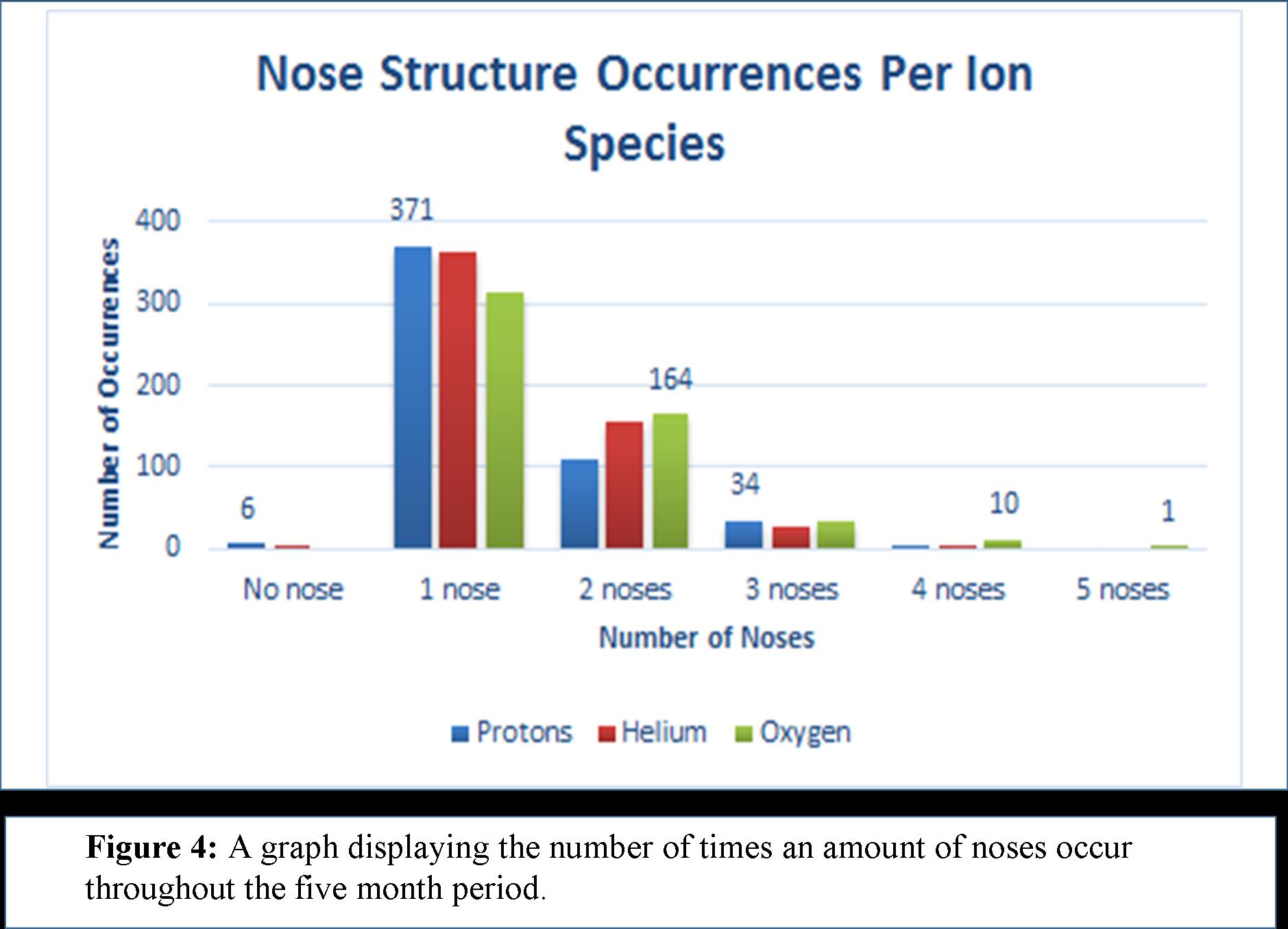
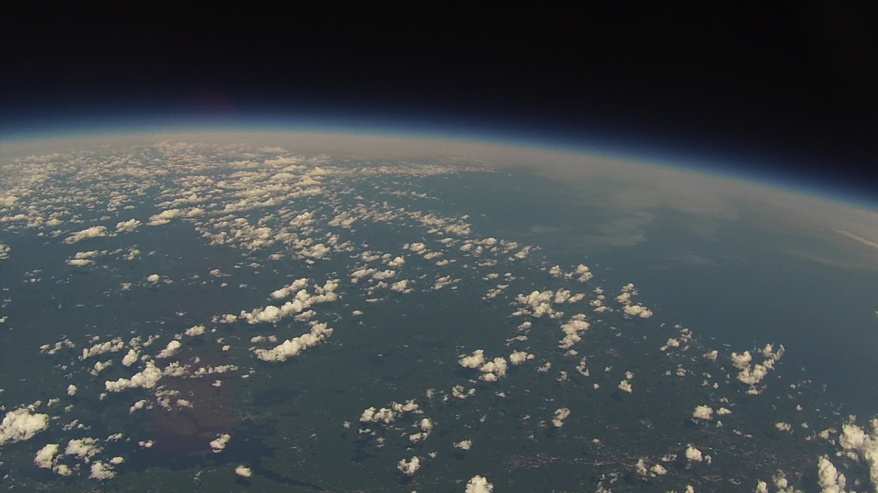
(left) Occurrence rates for nose distribution of ions as seen by the RBSP spacecraft for different
ion species. See Hollick and Pine 2015 poster for more details.
(right) The view from 96,000 feet in July 2015. Despite a mechanical failure on launch, the
flight did succeed in getting excellent photographs of the Earth.
2014 Research Projects: This was a remarkable year. We had 12 students in the program and they completed 8 different research projects spanning a broad range of spacecraft and scientific problems. The balloon payload flew to 97,000 feet with 5 new and highly succesful scientific experiments in the payload with both video and still cameras. Three experiments were great improvements over past designs: two temperature sensors and a Geiger counter. Two experiments were entirely new: a Sun sensor and a UV/IR spectrometer. The jet stream was uncharacteristic in that it was flowing from south to north, so we were able to launch from the UNH campus and retrieve north of Lewiston-Auburn, Maine.
- SMART students Estarlyn Hiraldo and Uri-Jaun Hall worked with Prof. Noe Lugaz and undergraduate student Devin Thomas. They performed a study of coronal mass ejections (CMEs) using remote sensing data from the STEREO spacecraft to study the early evolution of the objects and then compared arrival times, speeds, and expansion factors when they reached Earth using ACE and Omni data. Here is their poster.
- SMART student Sarah Coffen worked with Prof. Marc Lessard to build a prototype of a magnetometer boom that is scheduled to fly on a cubesat one year from now. Magnetometer booms need to be light and stiff while also being easily and reliably extended after the spacecraft if launched. There has never been a magnetometer boom built for a cubesat due to its small size. Here is her poster.
- SMART students Madeline Hubbard and Matthew Shindel worked with Profs. Charlie Farrugia and Roy Torbert along with graduate student Fathima Muzamil in a study of magnetic reconnection at high latitudes tailward of the cusp region within the Earth's magnetosphere. Although a frequent occurence, it is rarely observed due to the lack of satellites in the appropriate location. One aspect that sets these events apart from the more commonly discussed reconnection events along the Sunward magnetopause is that they are enhanced by a northward interplantary magentic field. The students combed the CLUSTER spacecraft data to build a data base of 22 events that will be studied by researchers in the coming months. Here is their poster.
- SMART students Victor Pierre and Gary Hu worked with Prof. Nathan Schwadron and graduate student Fatemeh Rahmanifard to study energetic neutral atoms using the IBEX spacecraft. Energetic neutral atoms are produced through charge exchange near the boundary of our heliosphere and are used to map the interaction of the heliosphere (the region defined by the Sun's activity) and the interstellar medium. Here is their poster.
- SMART students Nick Payne and Jared Spang worked with Prof. Charles Smith to attempt to provide the New Horizons spacecraft with useful scaling laws that will enrich the study of Pluto when the New Horizons spacecraft gets there in July of 2015. They used Voyager 2 data from a variety of locations to try to correlate the magnetic field intensity with solar wind observations such as density and speed. The New Horizons spacecraft does not measure the magnetic field, but it will be useful in understanding the interaction of Pluto with the solar wind. Here is their poster.
- Having completed the above project, students Payne and Spang performed a second study involving the magnetic waves excited by newborn interstellar pickup ions. They studied some very interesting events, but the application of a recent theory failed to compare favorably to the observations. An older theory was being programmed as the effort came to a close. Here is their poster.
- SMART students Brandor Matos and and John Gadbois worked with Prof. Jichun Zhang and graduate student Cristian Ferradas in a study of ion structures observed by the Van Allen probes. The magnetosphere is a complex system involving the acceleration of many particle species and the interaction of those particles with the ambient fields. They attempted to measure the distribution functions of several ion species in an effort to understand the acceleration process responsible for them. Here is their poster.
- Our 2014 balloon flight was a great success. We flew 5 new experiments built entirely by the SMART students (2 temperature sensors, a new Geiger counter, a Sun sensor, and an IR and UV spectrometer. We have a poster describing the flight (The 2014 Balloon Flight). There are two videos of the flight this year. The first is a short movie edited from the payload camera the second is a short video that incorporates interviews before, during and after the launch. Thanks to Uri-Jaun Hall for editing the first video and setting it to music. Thanks to UNH Multimedia Producer Scott Ripley for editing the second.
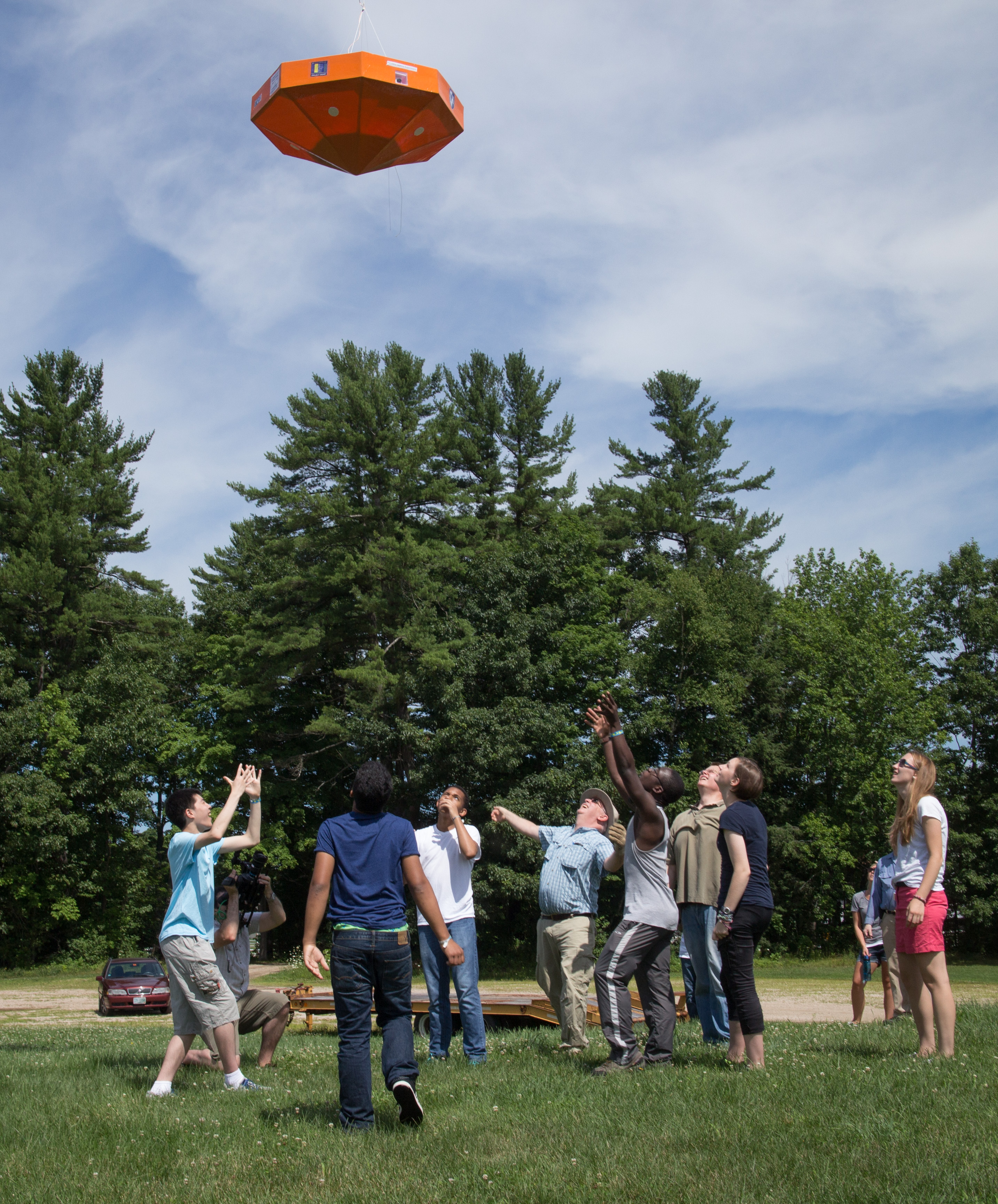
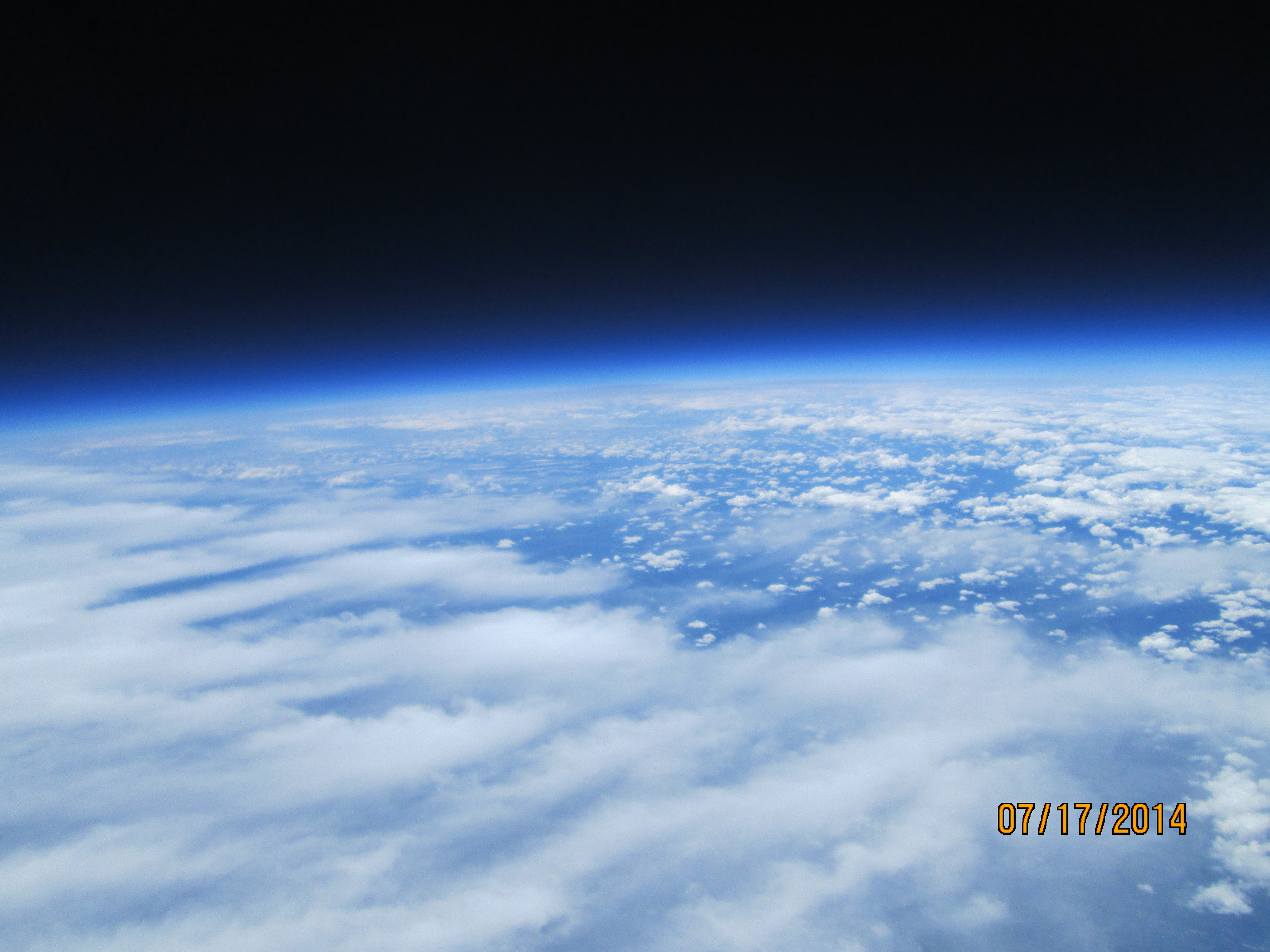
(left) Launch of the balloon payload in 2014 from Boulder Field on the UNH campus.
(right) The view from 27,000 feet in July 2014. Note the thin blue band that is our atmosphere
and the black of space above.
2013 Research Projects: This was a banner year. We had 8 students in the program and they completed 5 different research projects. They also flew 2 balloon payloads to 85,000 feet with succesful scientific payloads and video cameras. We even managed to capture images of one balloon from the other while ascending.
- SMART students Anthony Jones and Eloy Torres worked with Prof. Marc Lessard and UNH undergraduate students John Heavisides and Matthew Blandin to construct a ULF magnetometer and study ELF waves. The ULF magnetometer they constructed is destined to be deployed in the polar regions to make ground-based measurements in association with auroral studies. The ELF wave study was performed using data from a ULF magnetometer already deployed at high latitudes. Here is their poster.
- SMART students Nicholas Lajoie and Erich Trickel worked with Prof. Peter Bloser and teacher Rich Levergood to construct an interface between the gamma ray detector that Prof. Bloser had build earlier and the onboard command and data collection hardware that the SMART program is evolving. In the process, the students learned about gamma rays and their measurement. Here is their poster.
- SMART students Sita Mishra and Arianna Zrzavy worked with Prof. Li-Jen Chen, UNH graduate student Jason Shuster, and Penn State undergraduate student Megan McLaurin with help from Dr. Chris Mouikis. They performed a study of magnetic reconnection using data from the CLUSTER spacecraft in anticipation of the launch of the MMS mission. They found and analyzed a particularly interesting event. Here is their poster.
- SMART student Brandon Ng worked with Prof. Charles Smith and UNH undergraduate student Molly Goelzer to compute the motion of the Alfven radius with changing solar wind conditions. The Alfven radius is the location in space where the speed of low-frequency magnetic waves propagation equals the solar wind speed. The upcoming Solar Probe Plus mission will become the first spacecraft to pass inside this region. Inside the Alfven radius the local physics of interplanetary space is expected to be quite different from anything previously measured. Here is his poster.
- SMART student Sara Pesavento worked with Profs. Jichun Zhang and Lynn Kistler and UNH graduate students Robert Allen and Anthony Saikin to study ground-based observations of EMIC waves that were simultaneously observed by the CLUSTER spacecraft. The propagation of these low-frequency magnetic waves to ground provides new insights into their sourcs. Here is her poster.
- Our 2013 balloon flights (we flew 2 this summer) were a great success. We have a poster describing the flight (The 2013 Balloon Flight) of SMARTSat VI Alpha and a short movie edited from the payload camera. Thanks to Arianna Zrzavy for editing the video and setting it to music.
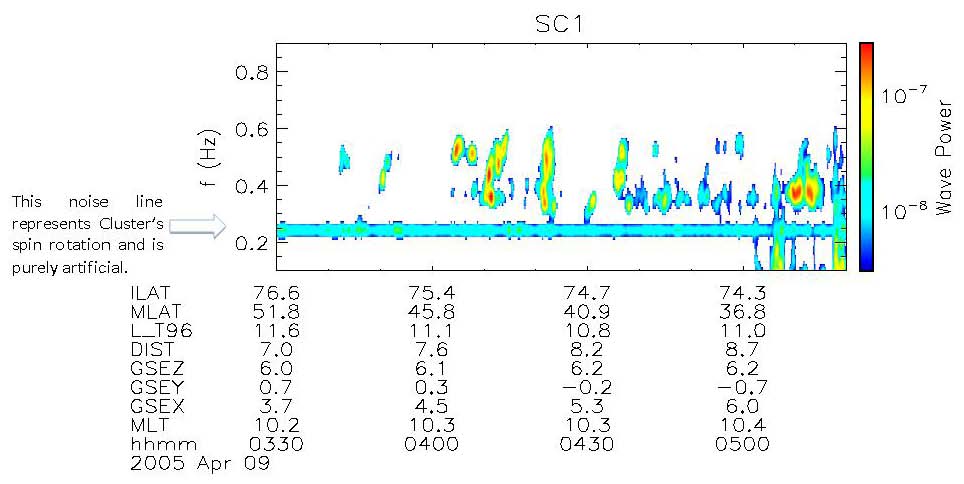
(above) Spectrogram of EMIC waves studed in 2013 Project SMART.
The source of these low-frequency magnetic waves in the magnetosphere are not well understood
and are the subject of considerable research involving the RBSP spacecraft.
2012 Research Projects: This year the program was smaller than usual wth only 3 students participating. Despite this, we accomplished a complete program with 3 research projects and a successful balloon flight. This was the first year that we flew an onboard microcontroller resulting in successful measurements of cosmic radiation, atmospheric pressure and temperature in a flight that reached 105,000 feet.
- SMART student Andrew Mahn worked with Profs. Charles Smith and Bernie Vasquez and UNH graduate student Kristoff Paulson in a study of plasma flow around Coronal Mass Ejections (CMEs). They used data from the Advanced Composition Explorer (ACE) spacecaft. The study served as an initial examination in preparation for a test of a theory that rapidly expanding CMEs exhibit pileup within the sheath region as they are unable to shed plasma. Here is his poster.
- SMART student Andrew Mahn worked on 2 separate projects this year. In his second project he worked with Prof. Roy Torbert and UNH scientist Pieter Beckman calibrating the Magnetospheric Multiscale (MMS) spin-plane double probe. Here is his poster.
- SMART students Emerson Montano and Malcolm LeClair worked with Prof. Marc Lessard and UNH researcher Paul Riley to build a Helmholtz coil for the purpose of neutralizing the Earth's magnetic field in calibrations of magnetometers. Here is their poster.
- The 2012 balloon flight was the first time we flew the onboard microprocessor for data collection and autonomous control of the flight. We have a poster describing the flight (The 2012 Balloon Flight) of SMARTSAT 2012 and a short movie edited from the payload camera. On the same flight we had an upward looking video camera shooting 30 frames/second that captured the balloon as it burst. To view that slow-motion video check out The 7-sec Burst Video.
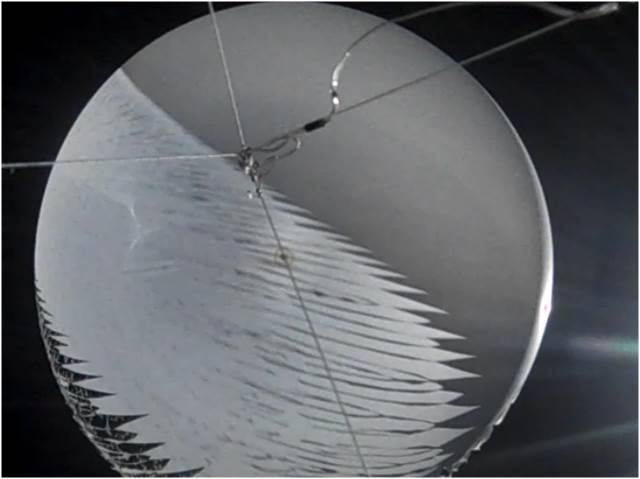
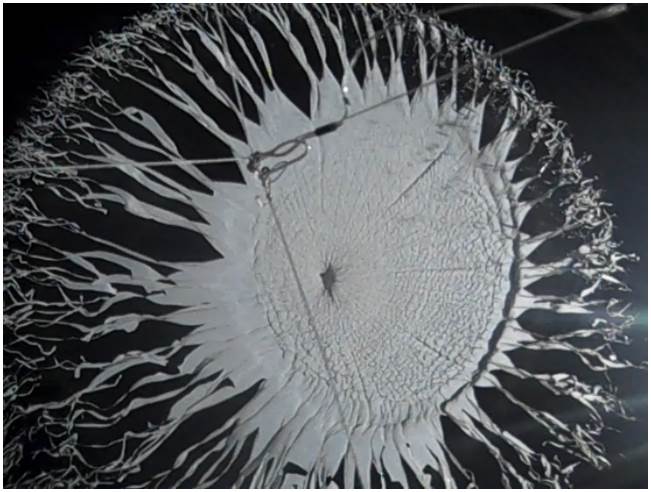
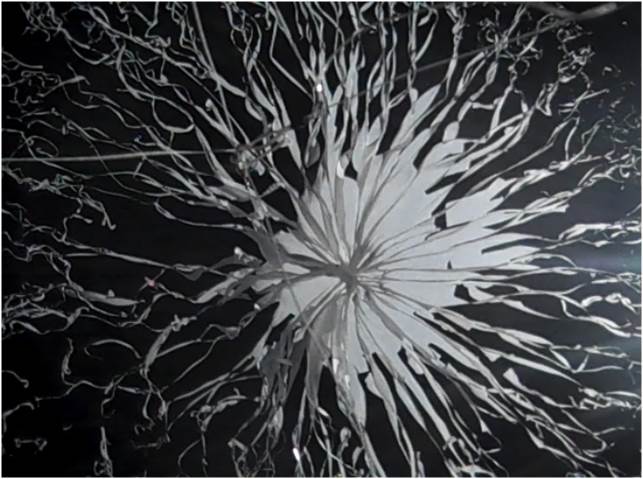
(above) Three sequential images filmed at 30 frames/second showing the balloon bursting in flight.
The balloon reached 105,000 feet.
2011 Research Projects: We had 9 students in the program in 2011 and we completed 5 research projects in addition to a balloon launch.
- SMART students Julia Mariel Heredia and Cabrera worked with Prof. Charles Smith and former SMART student Megan McLaurin in an analysis of low-frequency magnetic turbulence as observed in interplanetary space by the Voyager spacecraft. This was highly preliminary work that Smith and McLaurin, together with Prof. Bernie Vasquez and UNH student Colin Joyce continue to pursue. Here is their poster.
- SMART students Isabella Pagano and Meghan Fisher worked with Prof. Li-Jen Chen, UNH undergraduate student Jason Shuster, and UNH researcher Guanlai Li in a study of magnetic reconnection as seen by the CLUSTER spacecraft. Here is their poster.
- SMART students Eric Gutermann and Bradley Olsen worked with Prof. Roy Torbert and the MMS engineering team to test the deployment motor for the MMS Double Probe experiment. This is hardware that is destined to fly in space beginning in October 2014. Here is their poster.
- SMART students Danielle Jacques and Dimitrios Tsaras worked with Prof. Jimmy Raeder and his team to compute entropy within the magnetosphere. They used data from the THEMIS spacecraft. Their work revealed that entropy is both highly variable and related to the overall structure of the magnetosphere. Here is their poster.
- SMART student Adam White worked with Prof. Marc Lessard and UNH undergraduate students Matt Young and Drummond Biles to construct a cubicle quad antenna design for the purpose of monitoring electromagnetic fluctuations in the Earth's ionosphere and magnetosphere. This is a ground-based instrument that can be deployed in arctic regions to study the processes associated with auroral dynamics and other processes. Here is his poster.
- The 2011 balloon flight included a Geiger counter to measure cosmic radiation as a function of altitude. It is long established that both space and the Earth are sources of radiation. We have a poster describing the flight (The 2011 Balloon Flight).
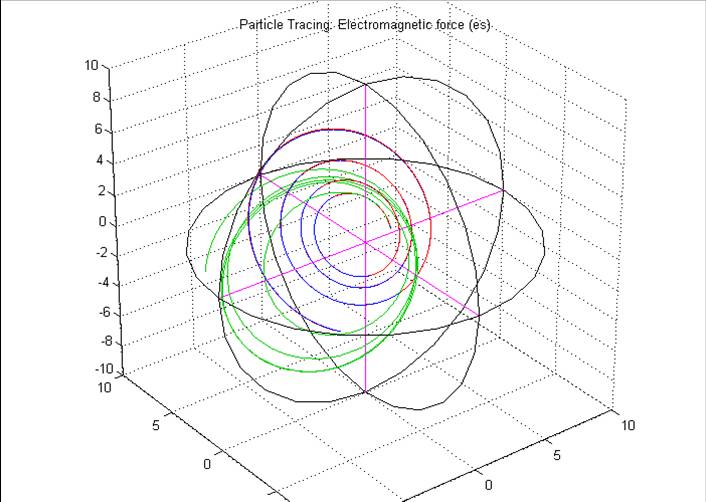
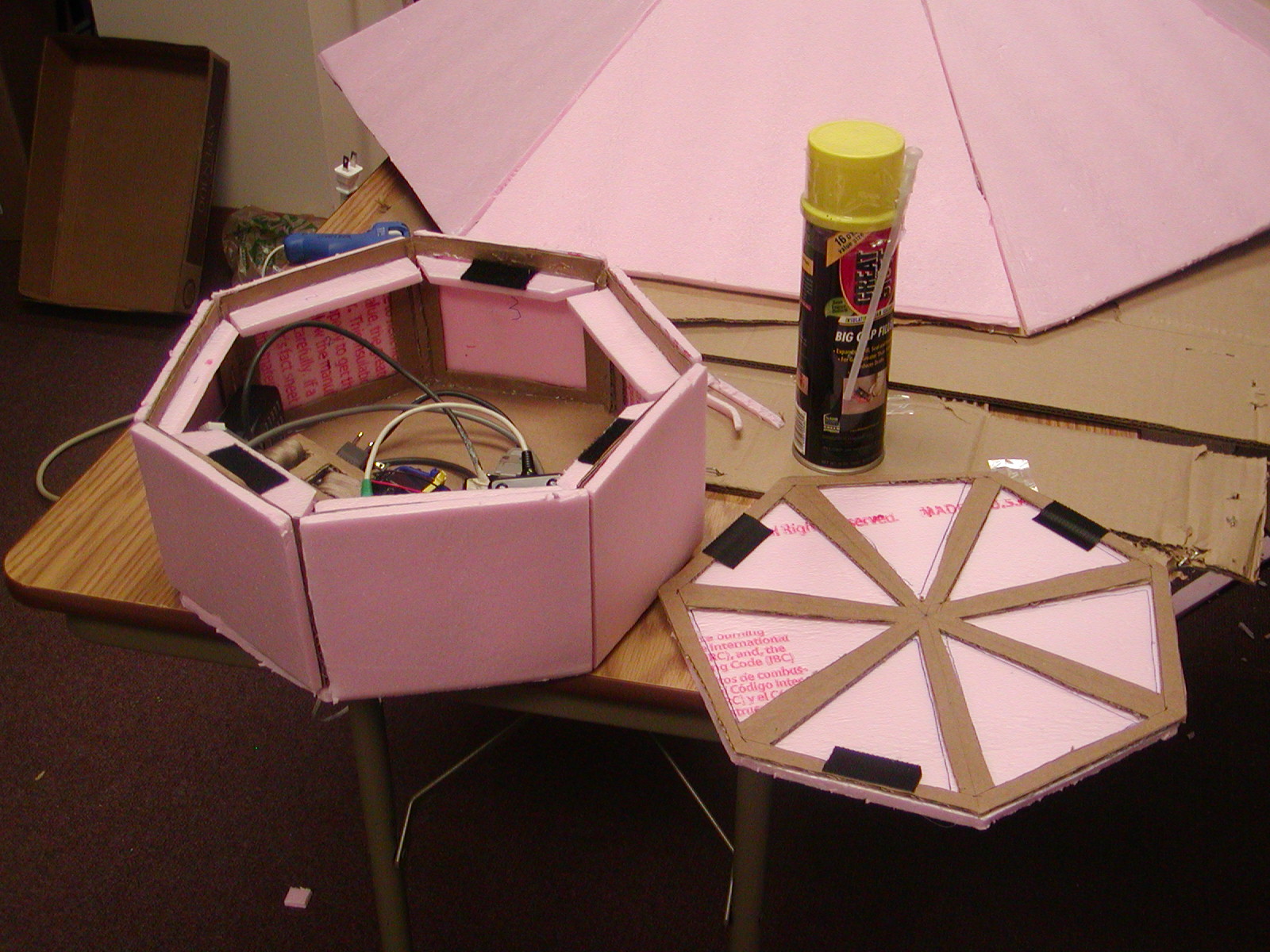
(left) Comparison of electron orbits as computed for spacecraft charging analysis.
(right) Early construction stage of 2010 balloon payload.
2010 Research Projects: We had 4 students in the program in 2010 and we completed 3 research projects in addition to a balloon launch.
- SMART student Megan McLaurin and Vasilis Morkotinis worked with Prof. Charles Smith and UNH undergraduate student Brad Cannon in a study of low-frequency magnetic waves excited by newborn interstellar pickup ions. These ions originate as neutral atoms in interstellar space, cross the heliosphere, and are eventually ionized by charge exchange with a solar wind ion or photoionization. The resuting energetic ions excite waves that were seen in magnetometers on the Ulysses spacecraft. They analyzed Ulysses data in an effort to characterize the waves and the conditions under which they are seen. Here is their poster.
- SMART student Luke Champine worked with Prof. Marc Lessard and UNH undergraduate student Matthew Young observing ionospheric opacity with a riometer and optimized antenna. This work is part of Marc's arctic research effort that combines ground-based and rocket-borne observations. Here is his poster.
- SMART student George Varvoglis worked with UNH graduate researcher Rich Messeder in a study of spacecraft charging that was important to the design of the MMS spacecraft. Spacecraft charging is a common problem and can have significant negative impacts in the measurement of low-energy electrons which are critical to the MMS mission. Here is his poster.
- The 2010 balloon flight was the first to test the descending body design of the payload that returns to Earth without a parachute. A significant effort went into the design and testing of the platform. Regretably, the payload landed 12 miles out to sea and was lost along with the scientific measurements and the video. We have a poster describing these efforts (The 2010 Balloon Flight).
To see an overview of the faculty who regularly participate in the Space Science component of Project SMART, go here....
Financial support for Project SMART is provided by the Dean of the College of Life Sciences and Agriculture, the Dean of College of Engineering and Physical Sciences, NH Space Grant Consortium, NSF-NH EPSCoR Grant, NH Sea Grant program, and the UNH Nanogroup.
